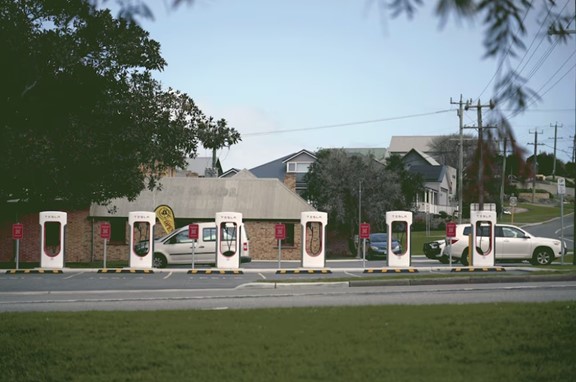
The EV Boom: A Driver of Electricity Demand and a Double-Edged Sword for the Power Grid
Peter Petrovsky is far from your average consumer. As an early adopter of technology, he purchased his first electric vehicle (EV) a decade ago, back when the industry in Australia was still in its infancy. But it wasn't just his love for tech that drew him in.
"The instant torque you get from an electric motor is unmatched," says the Perth-based father of two, comparing it to some of the fastest petrol-powered cars like Bugatti, Lamborghini, and Ferrari. "People come to EVs for various reasons—some love the tech, others are motivated by environmental concerns, and some are thrilled by the performance."
For a multitude of reasons, EV adoption in Australia is steadily increasing. Although sales dipped slightly in the last quarter, EVs accounted for more than 8% of all new car sales in the three months leading up to June 30, a significant jump from just 1.12% during the same period in 2022, according to the Australian Automobile Association.
A Surge in Demand
The rapid growth in EV sales is fueling expectations that they will soon dominate Australia's roads. The federal government has set a target for half of all new car sales to be electric by 2030, with some regions like the ACT aiming even higher—80 to 90% of light vehicle sales being "zero-emissions" by the same year.
This surge in EVs is also expected to drive a massive increase in electricity demand for transport. Ausgrid, which services over 4 million people from Sydney CBD to the Hunter Valley, highlighted in a federal parliamentary inquiry that "annual energy consumption from EV charging" is expected to soar from around 20 gigawatt-hours now to over 1,500GWh by 2028-29.
Endeavour Energy, covering Sydney's greater west and the NSW south coast, similarly forecasted that demand for EV charging in its network would leap from 48GWh to 635GWh over the same period.
Energy consultant Peter Kerr of ATA Consulting believes the future of the transport industry is clear: electric vehicles will increasingly replace internal combustion engine (ICE) cars. "Electric is proving itself technologically superior to ICE engines, and major manufacturers are pushing hard to electrify their entire line-up," he says.
Kerr warns that the surge in demand for power due to EVs will have profound implications for the power grid and could lead to higher costs for consumers. Unlike most electric devices, EVs require a significant amount of power to charge, especially larger vehicles like electric RAMs and Fords, which can draw hundreds of kilowatts.
The Challenge and Opportunity of Peak Demand
The size of EV batteries poses both a risk and an opportunity as the transition to electric transport accelerates. Andrew Blaver, head of energy transition and sustainability at Western Power, a state-owned poles-and-wires company in WA, acknowledges the pressure that EV charging could place on the grid if done during peak times. However, he believes this pressure is not inevitable.
Currently, most EV owners charge their vehicles using standard power outlets, which draw about as much energy as a kettle. However, fast chargers, which are the size of a large air conditioner, can increase demand on the network by 30 to 50%.
Blaver argues that network companies have a strong incentive to encourage EV owners to charge their vehicles outside of peak times—such as during the middle of the day when solar power is abundant. This would not only help shift demand away from peak hours but also save consumers money.
"Before we consider upgrading the grid, which should be a last resort, we must work with customers and agencies to promote off-peak charging and make use of excess renewable energy," Blaver says.
Batteries as a Potential Grid Resource
Looking ahead, Blaver sees the potential for EV batteries to support the grid in what's known as "vehicle-to-grid" technology. This concept involves using the energy stored in EV batteries to stabilize the grid during peak times or emergencies. "We could tap into the energy stored in EV or home batteries to alleviate grid pressure," he explains.
However, this idea is not without its challenges. Some automakers, like Tesla, have resisted the concept, and there are concerns about whether consumers would be willing to let third parties access their car batteries.
Kerr agrees that vehicle-to-grid technology relies on big assumptions, but he also points out that not every EV owner or automaker needs to participate for it to be effective. "There's no silver bullet in this transition. Some people may be reluctant to give up control of their batteries, but even a partial uptake could make a difference," he says.
In the meantime, Kerr suggests that there are simpler steps that can be taken to prepare for the EV revolution, such as burying power lines underground to increase capacity. "New underground cables are typically larger, so they can carry more electricity," he notes.
Peter Petrovsky, the Perth EV owner, remains optimistic that Australia can manage the transition to cleaner transport responsibly. "I don't think EVs will pose a problem for the grid as long as they're managed properly," he says. "When I ordered my first EV back in 2014, people were worried about the grid's capacity. But just like the shift from horse-drawn carriages to motorcars, I believe we'll find a way to adapt."